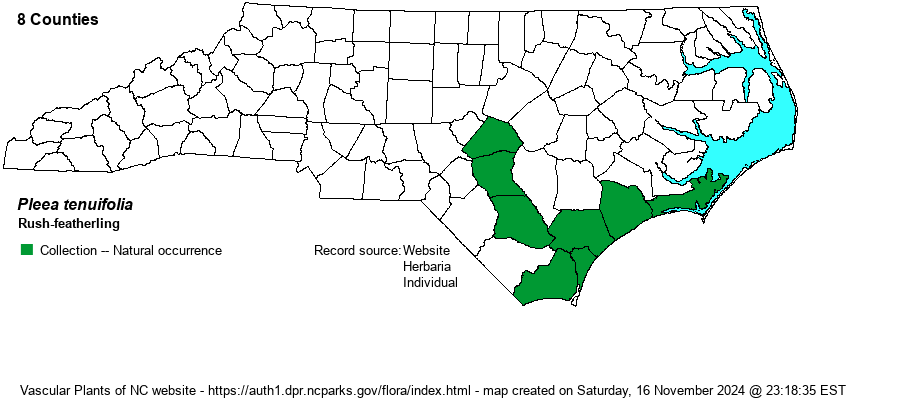| Author | Michaux | |
| Distribution | Restricted mainly to the southern coastal counties, from Carteret south to Brunswick. Also sparingly inland in the southern Coastal Plain as far as Cumberland and Harnett counties (both with small populations on Fort Bragg only).
This Coastal Plain species has a highly disjunct range. It has one "node" in southeastern NC and adjacent SC, and then is disjunct to northern FL and southern AL. It has yet to be recorded from GA. | |
| Abundance | Generally uncommon and local in coastal counties, but can occur in quite large stands of over 1,000 individuals in showy masses when in full bloom. Very rare now farther inland. Most locales now are probably in managed/preserved sites such as Holly Shelter Game Land and Green Swamp Preserve. | |
| Habitat | This species is limited mainly to the wetter portions of pine savannas, but it also can occur along pocosin margins. It typically occurs in peat-based soils. In the Sandhills, it occurs in wet streamhead seepages. Oddly, RAB (1968) states only "Pocosins", but not savannas. | |
| Phenology | A late-blooming species, of the fall season -- September and October; it fruits in October and November. | |
| Identification | This is a very grass-like lily when not in bloom, consisting of a clump of evergreen, very narrow and grass-like basal leaves to about 6-9 inches tall. In fall, the leafless flowering scape reaches about 1.5-2 feet tall, with fairly large flowers scattered singly up and down the upper part of the scape. Each flower has 6 narrow tepals, and the spread flower is about 1 inch across; flowers are white to cream in color, resembling a star. As all leaf parts are very narrow, when not in bloom an observer can easily walk past a stand of the species without noticing they are among lilies, but when in bloom the effect of large numbers of white "stars" is striking and simply unforgettable owing to its habit of growing in extensive stands. The many rounded capsules can be conspicuous in late fall, to help identification after blooming, but in summer prior to blooming the species can be very difficult to locate. | |
| Taxonomic Comments | None. In fact, this is the only species in the genus Pleea.
| |
| Other Common Name(s) | Surprisingly and thankfully, no other name seems in usage. | |
| State Rank | S3 | |
| Global Rank | G4 | |
| State Status | | |
| US Status | | |
| USACE-agcp | OBL link |
| USACE-emp | OBL link |

